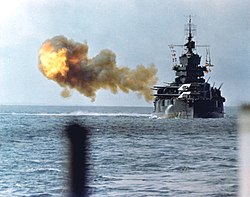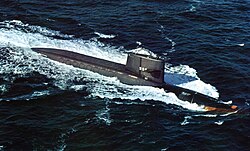United States Navy
The United States Navy is part of the U..S. Armed Forces (the military of the United States). It is the largest navy in the world, with the estimated tonnage of its active battle fleet alone exceeding the next 13 navies combined, including 11 U.S. allies or partner nations.[1][2][3][4] It has the highest combined battle fleet tonnage[1][5] and the world's largest aircraft carrier fleet, with eleven in service, two new carriers under construction, and five other carriers planned.
With 336,978 personnel on active duty and 101,583 in the Ready Reserve, the U.S. Navy is the third-largest U.S. military service branch in terms of personnel. It has 290 deployable combat vessels and more than 3,700 operational aircraft, as of June 2019[update].[6]
History
The Continental Navy was started in 1775 to fight in the American Revolutionary War. Congress disbanded it and sold the ships in 1785. It was started again as the Department of the Navy on April 30, 1798.
The Department of the Navy needed places to make ships, which are called shipyards, in various port cities. Where slaves were available, it paid slaveowners to rent their slaves. Shipyards with slaves included those of Washington, D.C.;[7] Norfolk, Virginia;[8] and Pensacola, Florida.[9]
Sailors
Today, the U.S. Navy has over 300,000 sailors and officers, and almost another 100,000 workers who are not official sailors. [10]
Strength
The U.S. Navy has about 300 warships, ships designed for fighting.[10] The largest warships are aircraft carriers, which have large and flat decks that act as small airports for planes carrying weapons. The U.S. Navy has more of aircraft carriers than any other navy in the world and a large number of planes in naval aviation. Aircraft carriers are often protected by smaller ships, called cruisers or destroyers. [11]
Ranks
| Rank | Title | notes |
|---|---|---|
| E-1 | Recruit | These ranks are divided into four groups: Seaman, Airman, Constructionman, and Fireman. The rank uses both the group and the title. For example, an E-2 (apprentice) who is a Seaman is a Seaman Apprentice. An E-3 uses just Seaman, Airman, Constructionman, or Fireman. |
| E-2 | Apprentice | |
| E-3 | Seaman, Fireman, Constructionman, or Airman | |
| E-4 | Petty Officer 3rd class | Petty Officers are more commonly referred to by their speciality ("rate") and class. For example, an Electronics Technician (ET) who is an E-5 is called an Electronics Technician 2nd class (ET2) |
| E-5 | Petty Officer 2nd class | |
| E-6 | Petty Officer 1st class | |
| E-7 | Chief Petty Officer | Chief Petty officers are commonly referred to by their level as chief (Chief, Senior Chief, or Master Chief) and officially by their level and rate (Chief Electronics Technician - ETC, Senior Chief Electronics Technician - ETCS, Master Chief Electronics Technician - ETCM) |
| E-8 | Senior Chief Petty Officer | |
| E-9 | Master Chief Petty Officer | |
| E-10 | Master Chief Petty Officer of the Navy |
There is only one Master Chief Petty Officer of the Navy at a time. |
| O-1 | Ensign | |
| O-2 | Lieutenant Junior Grade | Commonly just Lieutenant but sometimes Lieutenant JG used |
| O-3 | Lieutenant | |
| O-4 | Lieutenant Commander | |
| O-5 | Commander | |
| O-6 | Captain | Same as the rank of Commodore in many other navies |
| O-7 | Rear Admiral | There are two ranks of Rear Admiral. While both are called the same, O-7 is Rear Admiral lower half. The lower half is used when only very formally. |
| O-8 | Rear Admiral | |
| O-9 | Vice Admiral | |
| O-10 | Admiral | The rank of Fleet Admiral is also O-10 but is used only in wartime |
USS Constitution vs HMS Guerriere during the War of 1812
The Great White Fleet demonstrating U.S. naval power in 1907; it was proof that the U.S. Navy had blue-water capability.
Battleship USS Idaho shelling Okinawa on 1 April 1945
On Navy Day, 27 October 1945, the U.S. Post Office issued a commemorative stamp in honor of the Navy and the end of WW2.
USS George Washington, a ballistic missile submarine
Related pages
References
- ↑ 1.0 1.1 "The Russian Navy is aiming to be much larger than The US Navy". Business Insider. 24 September 2014. Archived from the original on 26 November 2015. Retrieved 12 November 2015.
- ↑ "Carl Lavo: The gigantic advantage the U.S. Navy has over all others". carllavo.blogspot.de. 9 March 2015. Archived from the original on 23 October 2015. Retrieved 12 November 2015.
- ↑ "If More Money Buys a Smaller Fleet, What Will Less Money Buy?". Time. 3 December 2012. http://nation.time.com/2012/12/03/if-more-money-buys-a-smaller-fleet-what-will-less-money-buy/. Retrieved 13 May 2015.
- ↑ "Speech View". defense.gov. Archived from the original on 21 May 2010. Retrieved 12 November 2015.
- ↑ Gates, Robert M. (January–February 2009). "A Balanced Strategy: Reprogramming the Pentagon for a New Age". Foreign Affairs. Council on Foreign Relations. Archived from the original on 5 August 2013. Retrieved 27 July 2013.
- ↑ "The U.S. Navy". U.S. Navy. 23 August 2019. Archived from the original on 14 June 2018. Retrieved 28 August 2019.
- ↑ Arnebeck, Bob (2014). Slave Labor in the Capital: Building Washington's Iconic Federal Landmarks. History Press. ISBN 978-1-62619-721-3.
- ↑ COLLISON, Gary Lee (2009-06-30). Shadrach Minkins. Harvard University Press. ISBN 978-0-674-02979-8.
- ↑ Clavin, Matthew J. (2015-10-12). Aiming for Pensacola. Harvard University Press. ISBN 978-0-674-08825-2.
- ↑ 10.0 10.1 "The U.S. Navy". www.navy.mil. Archived from the original on 2020-07-27. Retrieved 2020-07-22.
- ↑ "US Navy Ships". www.navy.mil. Archived from the original on 2020-07-27. Retrieved 2020-07-22.








